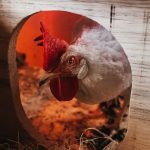Keeping chickens at school offers numerous benefits for students, teachers, and the school community. It provides students with hands-on experience in animal care, responsibility, and sustainability. Through caring for chickens, students can develop empathy and understanding of sustainable agricultural practices.
Chickens serve as a valuable educational resource across various subjects. In science, students can study the chicken life cycle. Mathematics can be applied through measuring and weighing eggs.
Social studies classes can explore the historical and cultural significance of chickens. This practical approach to learning makes academic concepts more tangible and engaging. The presence of chickens at school can also foster a sense of community.
It creates a shared responsibility and common interest that brings students, teachers, and parents together. This collaborative effort can enhance the overall school environment and promote a sense of belonging among community members. In summary, the benefits of keeping chickens at school extend beyond the classroom, positively impacting the educational experience and school atmosphere.
Table of Contents
- 1 Setting Up a Chicken Coop on School Grounds
- 2 Incorporating Chickens into the Curriculum
- 3 Health and Safety Considerations for Keeping Chickens at School
- 4 Involving Students in the Care of Chickens
- 5 Using Chickens to Teach Responsibility and Sustainability
- 6 Community Engagement and Outreach through School Chickens
- 7 FAQs
- 7.1 What are the benefits of keeping chickens at school in the UK?
- 7.2 What are the legal requirements for keeping chickens at school in the UK?
- 7.3 What are the potential challenges of keeping chickens at school in the UK?
- 7.4 How can schools incorporate chickens into the curriculum?
- 7.5 Are there any funding opportunities for schools to start a chicken-keeping project?
Key Takeaways
- Keeping chickens at school provides hands-on learning opportunities for students in various subjects such as biology, agriculture, and sustainability.
- Setting up a chicken coop on school grounds requires careful planning and consideration of local regulations and zoning laws.
- Chickens can be incorporated into the curriculum through activities such as egg hatching, observing chicken behavior, and learning about the life cycle of chickens.
- Health and safety considerations for keeping chickens at school include proper sanitation, disease prevention, and safe handling of chickens.
- Involving students in the care of chickens teaches responsibility, empathy, and the importance of sustainable practices.
- Chickens can be used as a tool to teach students about sustainability, food production, and the impact of their choices on the environment.
- School chickens can be a valuable resource for community engagement and outreach, providing opportunities for partnerships with local organizations and educational experiences for the wider community.
Setting Up a Chicken Coop on School Grounds
Choosing the Right Location
When selecting a location for the chicken coop, it’s essential to consider several factors. The coop should be situated away from high-traffic areas and potential hazards, and should have access to sunlight, fresh air, and protection from predators.
Designing a Safe and Comfortable Coop
The chicken coop should be designed with the comfort and safety of the chickens in mind. This includes providing adequate space for the chickens to move around, roosting areas for resting, nesting boxes for laying eggs, and proper ventilation to maintain air quality. The coop should also be secure and predator-proof to protect the chickens from potential threats.
Maintenance and Health Checks
Regular maintenance is crucial to ensure the health and hygiene of the chickens. This includes regular cleaning of bedding, nesting boxes, and feeding areas, as well as monitoring for signs of illness or distress in the chickens. By setting up a well-designed and properly maintained chicken coop, schools can create a safe and comfortable environment for their feathered residents.
Incorporating Chickens into the Curriculum

Incorporating chickens into the curriculum can provide valuable learning opportunities across various subjects. In science class, students can study the life cycle of chickens, learn about animal behavior and biology, and explore topics such as genetics and evolution through the study of different chicken breeds. Additionally, students can gain practical knowledge about animal care and nutrition by participating in the daily care of the chickens.
In math class, chickens can be used as a real-life context for learning about measurement, data analysis, and even geometry. For example, students can measure and record the growth of chicks over time, calculate the average number of eggs laid per week, or design and build structures for the chickens to roost or nest in. This hands-on approach to math can make abstract concepts more concrete and relevant for students.
Furthermore, incorporating chickens into the curriculum can also provide opportunities for creative expression and critical thinking. Students can write stories or poems about their experiences with the chickens, create art projects inspired by the birds, or engage in discussions about ethical considerations related to animal welfare and sustainable agriculture. By integrating chickens into various aspects of the curriculum, schools can enrich the learning experience for students and foster a deeper understanding of the natural world.
Health and Safety Considerations for Keeping Chickens at School
When keeping chickens at school, it’s essential to prioritize health and safety considerations to ensure the well-being of both the chickens and the school community. Firstly, schools should establish clear protocols for handling and caring for the chickens to minimize the risk of injury or illness. This includes providing training for students and staff on safe handling practices, proper hygiene procedures, and recognizing signs of distress or illness in the chickens.
In addition, schools should also implement measures to prevent the spread of disease between chickens and humans. This includes regular cleaning and disinfection of the chicken coop and equipment, as well as practicing good hygiene when interacting with the chickens. By promoting responsible animal care practices, schools can minimize health risks and create a safe environment for everyone involved.
Furthermore, schools should also consider potential safety hazards associated with keeping chickens on campus. This includes ensuring that the chicken coop is secure and predator-proof to protect the birds from harm, as well as implementing measures to prevent conflicts with other wildlife or pets in the area. By addressing health and safety considerations proactively, schools can create a positive and secure environment for keeping chickens on campus.
Involving Students in the Care of Chickens
Involving students in the care of chickens can provide valuable opportunities for hands-on learning and skill development. By participating in tasks such as feeding, watering, cleaning, and collecting eggs, students can develop practical skills related to animal care and responsibility. This hands-on experience can also foster a sense of empathy and connection with the chickens, promoting a deeper understanding of animal behavior and welfare.
Furthermore, involving students in the care of chickens can also promote teamwork and collaboration among peers. By working together to care for the chickens, students can learn to communicate effectively, problem-solve as a group, and take on shared responsibilities. This collaborative approach to caring for animals can help students develop important social and emotional skills that are valuable both inside and outside of the classroom.
In addition to practical skills and social development, involving students in the care of chickens can also promote a sense of pride and ownership in their school community. By taking an active role in caring for the chickens, students can see the direct impact of their efforts on the well-being of the birds and feel a sense of accomplishment in contributing to their school environment. Overall, involving students in the care of chickens can provide meaningful learning experiences that extend beyond academic knowledge.
Using Chickens to Teach Responsibility and Sustainability

Learning Responsibility through Chicken Care
By caring for chickens, students develop a sense of responsibility and accountability. They understand that their actions have a direct impact on the well-being of the chickens and learn to prioritize their needs. This hands-on experience helps students develop essential life skills, such as time management, organization, and empathy.
Sustainable Agriculture Practices
Keeping chickens at school provides an opportunity to teach students about sustainable practices in agriculture. Students can learn about environmentally friendly ways to raise chickens for eggs or meat, minimizing waste and promoting ethical treatment of animals. They can also discover the benefits of using chicken waste as fertilizer for gardens or composting it to reduce waste.
Long-term Impact on Environmental Stewardship
By integrating lessons about responsibility and sustainability through caring for chickens at school, educators can help students develop a deeper understanding of their role in preserving natural resources and promoting ethical treatment of animals. These lessons can have a lasting impact on students’ attitudes towards environmental stewardship and their ability to make informed choices that benefit both themselves and their communities.
Community Engagement and Outreach through School Chickens
Keeping chickens at school can also serve as a platform for community engagement and outreach. Schools can involve parents, local farmers, or animal experts in educational activities related to caring for chickens. This involvement not only enriches students’ learning experiences but also strengthens ties between schools and their communities.
Furthermore, schools can use their chicken program as an opportunity to educate the broader community about sustainable practices in agriculture and animal welfare. Open houses or workshops focused on chicken care can attract community members who are interested in learning more about raising backyard chickens or sustainable living practices. In addition to educational outreach, schools with chicken programs may also have opportunities to engage with local businesses or organizations that support sustainable agriculture or animal welfare initiatives.
By partnering with these entities, schools can further promote their commitment to responsible stewardship of natural resources while providing valuable learning experiences for their students. Overall, keeping chickens at school not only benefits students’ education but also provides opportunities for schools to connect with their communities around shared values related to sustainability and animal welfare. Through these connections, schools can foster a sense of belonging within their communities while promoting positive change on a larger scale.
If you’re considering keeping chickens at your school in the UK, you may also be interested in learning about the best location for your chicken coop. Poultry Wizard offers a helpful article on “Where to Put Chicken Coop” that provides valuable tips and considerations for setting up a suitable environment for your feathered friends. Check out the article here to ensure that your school’s chicken coop is in the ideal spot.
FAQs
What are the benefits of keeping chickens at school in the UK?
Keeping chickens at school in the UK can provide educational opportunities for students to learn about animal care, biology, and sustainability. It can also promote a sense of responsibility and empathy among students.
What are the legal requirements for keeping chickens at school in the UK?
Schools in the UK must comply with animal welfare regulations when keeping chickens. This includes providing appropriate housing, food, water, and veterinary care for the chickens. Schools may also need to obtain a license from their local council.
What are the potential challenges of keeping chickens at school in the UK?
Some potential challenges of keeping chickens at school in the UK include managing the daily care of the chickens, ensuring their welfare and safety, and addressing any concerns from students, staff, or parents about having chickens on the school premises.
How can schools incorporate chickens into the curriculum?
Schools can incorporate chickens into various subjects such as science, geography, and citizenship. Students can learn about the life cycle of chickens, the role of chickens in sustainable food production, and the ethical considerations of keeping animals.
Are there any funding opportunities for schools to start a chicken-keeping project?
Some schools in the UK may be eligible for funding or grants to support the establishment of a chicken-keeping project. This could come from government initiatives, local community organizations, or educational foundations.
Meet Walter, the feathered-friend fanatic of Florida! Nestled in the sunshine state, Walter struts through life with his feathered companions, clucking his way to happiness. With a coop that’s fancier than a five-star hotel, he’s the Don Juan of the chicken world. When he’s not teaching his hens to do the cha-cha, you’ll find him in a heated debate with his prized rooster, Sir Clucks-a-Lot. Walter’s poultry passion is no yolk; he’s the sunny-side-up guy you never knew you needed in your flock of friends!







